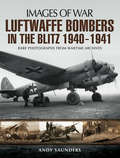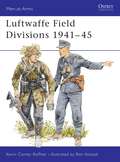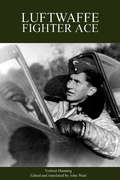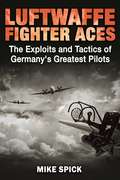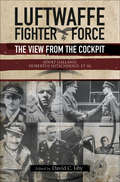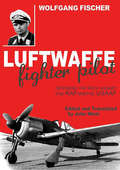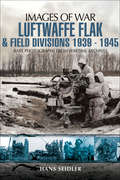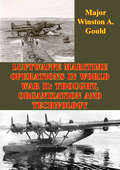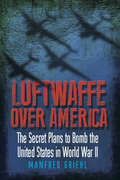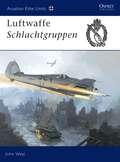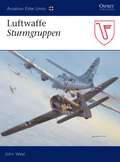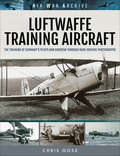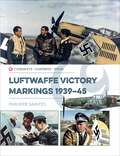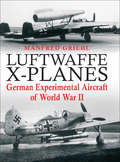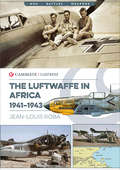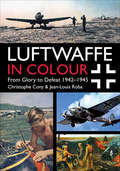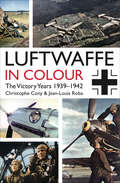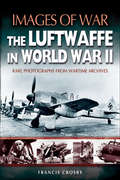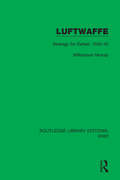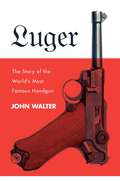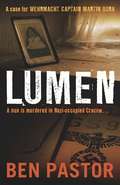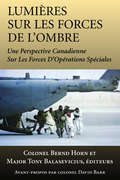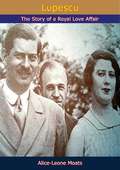- Table View
- List View
Luftwaffe Bombers in the Blitz, 1940–1941: Rare Photographs From Wartime Archives (Images of War)
by Andy SaundersLuftwaffe Bombers in the Blitz will comprise of some 140-150 images of German bomber aircraft during the Blitz of 1940-1941. The images will cover the entirety of the Blitz and will also depict losses across Britain during this period. Each picture will tell its own story, and will be fully captioned with historical detail. Each section will have a short introduction and the images will include those of shot down aircraft, including relatively intact machines, badly damaged/destroyed wreckages, photographs of pilots and other related illustrations. All images are from the author's unique collection of wartime photographs of Luftwaffe losses, collected from a variety of sources across some thirty-five years of research.
Luftwaffe Field Divisions 1941-45
by Ronald Volstad Kevin RuffnerHermann Göring raised the Luftwaffe Field Divisions [LwFD] during 1942, when Nazi Germany was still making spectacular gains but was first feeling the pinch of its losses on the Eastern Front. The Reichsmarschall decided to raise his own divisions for ground service under the command of Luftwaffe officers. On 17 September 1942, Göring called for volunteers from throughout the Luftwaffe for combat duty in the East. Even before that date, however, some Luftwaffe troops were heavily engaged against the enemy in Russia in a ground role. Kevin Conley Ruffner's engaging text tells the fascinating story of the LwFD during World War II.
Luftwaffe Fighter Ace: From The Eastern Front To The Defense Of The Homeland (Stackpole Military History Ser.)
by Norbert HannigA World War II memoir by the renowned German fighter pilot—from his Hitler Youth glider training to combat missions against the Soviet Air Force. Herr Norbert Hanning&’s wartime career makes for fascinating and highly informative reading on an aspect of the 1939-45 air war not often covered in the English language; primarily that of the campaign against the Soviet Union. He was one of the midwar-generation Luftwaffe fighter pilots and began operations with JG 54 on the eastern (Leningrad) front in early 1943; initially flying Messerschmitt Bf 109s before transitioning to the Focke-Wulf Fw 190. He became a Staffel CO and was credited with 42 victories, also serving with JV 44 (whose CO was Adolf Galland); he then returned to Germany towards the closing stages of the war to convert to Me 262 jet fighters. Many and varied were his experiences in action against the rejuvenated Soviet Air Force in the east, and the powerful western Allies over the homeland during the final chaotic months of hostilities, which culminated in his captivity. John Weal&’s skillful translation ensures that the fluid and descriptive style of the author is preserved. Thankfully, also, Norbert was a keen photographer who shot a profusion of images, all previously unpublished, many of which appear in this important book.
Luftwaffe Fighter Aces: The Exploits and Tactics of Germany's Greatest Pilots
by Mike SpickGet in the cockpit with some of the greatest German flying aces of all time! In this exciting book, Mike Spick shows how the Luftwaffe's leading fighter pilots were able to outscore their allied counterparts so effectively and completely during World War II. When the records of the Jagdflieger pilots became available after the war, they were initially greeted with incredulity—the highest claim was for 352 kills, and more than one hundred pilots had recorded more than one hundred victories. However, post-war research proved that these claims had in fact been made in good faith and confirmation had only been given after rigorous checking. To discover the secret of this success, aviation history expert Mike Spick examines the exploits of these aces and sets out the context in which they took place. Every major theatre is covered in detail including the conditions peculiar to each: climate, relative numerical and qualitative strengths, the presence or absence of radar and other measures, and the relative merits of the planes being flown. He focuses on the methods and tactics used by individual aces and uses first-hand sources wherever possible to put the reader right alongside the pilot in the cockpit.
Luftwaffe Fighter Force: The View from the Cockpit
by Adolf Galland Hubertus Hitschhold&“A fascinating book&” of thirty-four debriefings given by pilots and flight crew members—including the legendary German fighter ace Adolf Galland (HistoryOfWar.org). The Nazi air force pilot and crew members featured in this unusual collection divulge what was once highly-confidential information—including fighter tactics, aircraft technology and operations, and chain of command. Along with maps and diagrams, thirty rarely seen photographs are included featuring uniformed Luftwaffe officers, close-up shots of fighter planes, and the areas where the planes were authorized to carry out their missions. This unique volume was compiled by acclaimed military historian David C. Isby and is extraordinarily comprehensive. To make it, Isby poured over accounts of the war given by members of the Luftwaffe shortly after the events they describe. Much of the information in the book has been shared for the first time, and, after a limited run, is finally back in print. &“If you&’re a student of page-turning pilot memoirs from World War 2, this is a vital reference for understanding how the Luftwaffe&’s pilots functioned—and why. Regardless of whose story you&’re following, knowing how the opposing pilots came into each encounter will only enrich your appreciation of the outcome.&”—Airscape
Luftwaffe Fighter Pilot: Defending the Reich Against the RAF and the USAAF
by Wolfgang FischerA Nazi Germany fighter pilot gives readers a bird's-eye view from the cockpit of aerial combat against the Allied forces in World War II. Within weeks of war being declared, Wolfgang Fischer had volunteered to join the Luftwaffe and spent nearly five of the succeeding six years of hostilities in uniform. During this time he was given a succession of postings varying from a long-range recce unit; as a decoder in a met office in occupied France; to a bomber squadron; and as a flying instructor, before joining a squadron of the famous Richthofen Geschwader in Italy, from where he was shot down in his FW 190 by Mustangs en route to Normandy. By now a Lieutenant, he survived to fly offensive rocket attacks over Gold Beach on D-Day, only to be shot down again on D+1, and captured and sent first to a hospital in the UK, then into captivity in the USA. He was finally repatriated in April 1946. His description of all these events is entertaining and well-written, ranging from comic to tragic. It is unique in flavor, giving a valuable insight into the undeniably typical lot of those serving in the air arm of the Third Reich. Expertly translated and edited by John Weal, this is a worthy accompaniment to Norbert Hannig's Luftwaffe Fighter Ace published by Grub Street in 2004.
Luftwaffe Flak and Field Divisions, 1939–1945
by Hans SeidlerFrom the outset of WW2, Grings Luftwaffe Flak units saw extensive fighting with their 2cm, 3.7cm and deadly 8.8cm anti-aircraft guns. By the time of Hitlers invasion of Russia, Luftwaffe ground forces had been expanded and were being used in both the army support and air roles.After initial success on the Eastern Front turned to stalemate and huge losses, Hitler ordered the raising of Luftwaffe Field Divisions to bolster the Army. These were initially under Grings command but in late 1943 were handed over to the Army and reorganized as standard infantry divisions (of three two-battalion rifle regiments) retaining Luftwaffe designations. The most famous was the elite Hermann Gring Divisions, which was reorganized as a Panzer Division.By 1944 there were no less than twenty-one Luftwaffe Field Divisions plus many similar regiments, fighting on all fronts. Of all German anti-tank weapons, the 8.8cm gun was the most feared and destructive.This book describes the evolution of this unique element of the Nazi war machine by means of clear text and superb images.
Luftwaffe Maritime Operations In World War II: Thought, Organization And Technology
by Major Winston A. GouldThe development of airpower can be traced to three key elements: thought, organization and technology. The Luftwaffe of World War II is no different. This paper will examine the Luftwaffe's thought, organization and technology as it pertains to maritime operations, or as the modern United States Air Force (USAF) calls it, Countersea Operations. These maritime operations will include direct support of the Kriegsmarine and independent Luftwaffe operations against the Allies. Luftwaffe thought will show that doctrinally the Luftwaffe was not as prepared for the maritime role its leaders thrust upon it, but flexibility and the application of the tenets of airpower provided the basis for adaptation. Also included will be an examination of the fierce rivalry between the Luftwaffe and Kreigsmarine senior leadership and how this interfered with the conduct of countersea operations. Luftwaffe organization during World War II provided a more than adequate basis for conducting the countersea campaign. The adaptability of the operational and support structure allowed the Luftwaffe to accomplish a variety of missions, even as their aircraft and weapons were proving deficient. Finally, the Luftwaffe was at the forefront of innovation in the field of aviation technology, including airframe and weapon development. Once again, interference by senior leadership and equipment teething problems combined with increasing Allied attacks cost the Luftwaffe precious time.
Luftwaffe Over America: The Secret Plans to Bomb the United States in World War II
by Manfred GriehlThe plans that Nazi Germany had to raid - and bomb - New York and the eastern seabord are revealed in this book. They were were based on the use of transoceanic aircraft planes, such as the six-engined Ju 390, Me 264 or Ta 400, but the Third Reich was unable to produce such machines in sufficient numbers. If the Soviet Union had been conquered, however, these plans would have become a reality. With the seizure of vital resources from the Soviet Union the Wehrmacht would have had enough fuel and material to mass-produce giant bomber aircraft: it was a near run thing. The collapse of the Wehrmacht infrastructure and the end of the Thousand-Year Reich ensured that plans for long-range remote-controlled missiles never got off the drawing board and were never manufactured. Manfried Griehl makes it clear that until the collapse, numerous secret research laboratories seemed to have worked in parallel seeking nuclear power and explosives. Only classified material held within British, French and American archives can prove whether these groups were close to perfecting small atomic explosives. But, without a shadow of doubt, Germany was far more technologically advanced by the end of 1944 that has been previously suspected.
Luftwaffe Schlachtgruppen
by John WealOne of the most important, and yet least publicised, components of the front-line Luftwaffe was the Schlacht, or ground attack, arm. This book details the Schlacht units who were in the thick of the fighting from the first day of the war until the last. They played a vital part in the heady successes of the early Blitzkrieg campaigns and went on to perform an equally essential role in the dark hours of last ditch defence and ultimate defeat. In between, they fought in all defensive battles: on the eastern front at Stalingrad, Kursk and Berlin; in the west, by night, over Normandy, the Ardennes and the Rhine.The color plate section of the book has profiles of the following, disperate aircraft:HS 123AHE 51BBf 109-4Bf 109EBf 109E-7HS 129BFw 190F-2Fiat Cr.42Fokker CV-EJu 87DAll of which were flown by this squadron. Also of note is the fact that this Ace pilot Hans-Ulrich Rudel was part of this distinguished unit.
Luftwaffe Sturmgruppen
by John WealThe 'storm troopers' of the Luftwaffe, the elite Strumgruppen units comprised the most heavily armed and armoured fighter interceptors ever produced by the Germans. Their role was to smash like a mighty fist through the massed ranks of USAAF daylight bombers. Only volunteers could serve with these elite units, and each pilot was trained to close with the enemy and engage him in extremely short-range combat, attacking from the front and the rear in tight arrowhead formations. In exceptional circumstances pilots would even ram their enemy. This book chronicles the brief, but violent, career of the Sturmgruppen during the dark days of 1944-45, employing first-hand accounts and rare archival photography.From the Trade Paperback edition.
Luftwaffe Training Aircraft: The Training of Germany's Pilots and Aircrew Through Rare Archive Photographs (Air War Archive)
by Chris GossFrom a retired RAF Wing Commander, an introductory guide to the aerial warfare training methods implemented by Germany for airmen during World War II. The often-unnoticed element in aerial warfare is the training, yet its value is beyond calculation. The Luftwaffe used a variety of aircraft in this fundamental role, with trainee pilots progressing from simpler, older machines to the more sophisticated, as well as heavier aircraft. Gradually airmen were introduced to newer, faster models that enabled them to experience, to some degree, the type of aircraft they would fly in combat. Recruits would initially spend six months at a Fliegerersatzabteilung or training depot, where the main emphasis was on drill and physical training, with introductory lectures on the principles of wireless operation and map reading. This would be followed by two months studying general aeronautical subjects, before being sent to elementary flying school. The various kinds of aircraft used for training depended upon the role each individual trainee would eventually undertake, from single-seat fighters to multiple-crew bombers or transports. In this, the Luftwaffe was also able to make use of captured enemy aircraft. It also established training units through the Occupied territories to enable its trainees to familiarize themselves with different conditions and terrain. In the less-pressurized environment of the training schools away from the front line, more care could be taken over photography, resulting in the author of this extensive study of the wide range of aircraft used for training by the Luftwaffe, being able to assemble such a fine collection of excellent images.
Luftwaffe Victory Markings 1939–45 (Casemate Illustrated)
by Philippe SaintesA fully illustrated overview of the Nazi German Air Force&’s victory markings on their day & night fighter aircrafts in World War II. This book provides an overview of the victory markings painted on the fins and rudders of the planes of the German day fighter and night fighter aircraft between 1939 and 1945, and demonstrates how these were applied in reality through the profiles of nineteen pilots, including some of the most emblematic pilots of the Luftwaffe: Hans Troitzsch, Johannes Gentzen, Frank Liesendahl, Wilhelm Balthasar, Otto Bertram, Joachim Müncheberg, Karl-Heinz Koch, Kurt &“Kuddel&” Ubben, Felix-Maria Brandis, &“Fiffi&” Stahlschmidt, Franz-Josef Beerenbrock, Heinrich Setz, Walter &“Gulle" Oesau, Max-Hellmuth Ostermann, Heinrich Bartels, "Fritz" Dinger, Martin Drewes, Egmont zur Lippe-Weissenfeld and Ludwig Meister.Praise for Luftwaffe Victory Markings 1939–45 &“For any and all who seek out photos of the German WWII victory markings adorning their aircraft, this book is simply a &‘must have&’.&” —Large Scale Planes &“Will be of great interest to modelers who want to put victory markings on a Luftwaffe fighter model.&” —AMPS Indianapolis &“Modelers seeking to put a finishing detail on their aircraft will find this book quite useful.&” —Historical Miniatures Gaming Society
Luftwaffe X-Planes: German Experimental Aircraft of World War II
by Manfred GriehlThis illustrated WWII history reveals the full range of experimental military aircraft that the Third Reich nearly flew into combat. From jet planes and high-altitude aircraft to radar-equipped fighters configured to deliver chemical weapons, numerous secret Luftwaffe planes reached prototype stage during the Second World War. Had these innovative aircraft made it into combat, the course of the war could have gone very differently. Renowned aviation expert Manfred Griehl explores these projects through an informative and fascinating selection of images, including numerous wartime photographs. Despite the Allied authorities' ban on research, countless aircraft were designed and tested by the Luftwaffe and German manufacturers before World War II. The research went ahead at secret evaluation sites in Germany, Switzerland, Sweden and the USSR. Though this work continued after the outbreak of war, many projects were never completed, often because the developers simply ran out of time. This definitive guide reveals the remarkable range of planes that the Third Reich failed to complete.
Luftwaffe in Africa, 1941–1943 (Casemate Illustrated #Cis0015)
by Jean-Louis RobaThis WWII history examines Nazi air force operations in Egypt and Libya with more than 100 rare wartime photographs. When Mussolini&’s army was defeated on the Libyan-Egyptian border at the beginning of 1941, Adolph Hitler had no choice but to send reinforcements to help his ally. The Luftwaffe deployed an air detachment, first to Sicily, then to North Africa. This volume examines the small expeditionary force, solely devoted to protecting Italian possessions in the Mediterranean and Middle Eastern theater. When General Erwin Rommel launched his Afrika Korps to the east, the Luftwaffe had to go on the offensive to cover the advance. As British air forces were strengthened, German High Command was obliged to send more aerial units into what it had initially considered a peripheral arena of the war. Losses in bombers and fighters were high on both sides. By the time the Allies landed in Morocco and Algeria at the end of 1942, the Wehrmacht&’s fate was sealed. The last German units capitulated in Tunisia in May 1943.
Luftwaffe in Colour: From Glory to Defeat
by Christophe Cony Jean-Louis RobaNearly four hundred photos documenting the last years of the Luftwaffe: &“If you&’re interested in unit history then this book is a must have&” (Britmodeller.com). A companion to the first volume of Luftwaffe in Colour, which covered the victory years from 1939 to Spring 1942, this book contains even more fascinating material on the machines of the Luftwaffe and the men who flew them as their fate took an increasingly grim path. Initially, the Luftwaffe ruled the skies, but eventually, they fought an increasingly futile war of attrition that, when combined with vital strategic mistakes in aircraft production, was its death knell. Despite this, the Luftwaffe produced the most successful air aces of all time. Among many remarkable images, we see one of the last Junkers 87 B-2 operational on the Eastern Front during the winter of 1942-1943; the huge BV 222 V-5 of Lufttransportstaffel in the port of Heraklion in late 1942; pilots in Tunisia in 1943; the aces Hans Philipp, Wolfgang Späte, and Heinz Schnaufer; and a vivid demonstration of the reversal in fortunes in 1944 as Allied bombers destroy 106 sites, engulfing them in fire at Schwäbisch Hall on German soil. In this painstakingly curated collection, the full detail behind the propaganda is once more revealed in rare color photographs.
Luftwaffe in Colour: The Victory Years
by Christophe Cony Jean-Louis RobaA photo-packed look at the men and machines of one of history&’s legendary air forces. This remarkable work explores the Luftwaffe as it truly existed day-to-day, underneath the propaganda of their own regime and the stories of their enemies. In Hitler&’s Germany, color photography was primarily co-opted for state purposes, such as the military publication Signal or the Luftwaffe&’s own magazine, Der Adler. But a number of men had cameras of their own, and in this painstakingly acquired collection, we can witness true life on Germany&’s airfields during the period of the Luftwaffe&’s ascendancy. Not only do we see famous planes such as the Me-109, Ju-87, and He-111, but the wide variety of more obscure types with which the Germans began the war. The array of Arados, Dorniers, Heinkels—not to mention elegant four-engine Condors—that were initially employed in the war are here in plain sight and full color, providing not only an insight into WWII history but a model maker&’s dream. Just as fascinating are the shots of the airmen themselves, along with their ground crews—full of confidence and cheer as they bested every other air force in Europe during these years, with the single exception of the RAF&’s Fighter Command in late summer 1940. But that was no big stumbling block to the Luftwaffe, which had bigger fish to fry in Russia and North Africa the following year. &“Both volumes [The Victory Years and From Glory to Defeat] are a fantastic addition to your aviation library. The reproduction quality is superb.&” —War History Online
Luftwaffe in World War II (Images Of War Bks.)
by Francis CrosbyWorld War Two Luftwaffe aircraft and their pilots have been a source of fascination and respect to aviation buffs since 1945. This book looks at all aspects of its operation in many World War II theaters. A great majority of photographs are unlikely to have been seen by the general public and they have been superbly reproduced directly from original negatives held by the Imperial War Museum.Lengthy captions describe the action portrayed in each photo and an introduction puts the Luftwaffe into its historical perspective.
Luftwaffe: Strategy for Defeat, 1933–45 (Routledge Library Editions: WW2 #16)
by Williamson MurrayThis book, first published in 1985, is an in-depth analysis of the Luftwaffe in the Second World War, using previously untapped German archives and newly-released ‘Ultra’ intelligence records. It looks at the Luftwaffe within the context of the overall political decision-making process within the Third Reich. It is especially valuable for its careful study of industrial production and pilot losses in the conduct of operations.
Luger: The Story of the World's Most Famous Handgun
by Walter JohnThe distinctive look of the Luger and its role in German military history make it the world’s most famous handgun. In Luger, renowned gun expert John Walter traces the history of this semiautomatic pistol from an early design by Hugo Borchardt in the 1890s through its use in the trenches of the First World War to the final days of the Third Reich in WWII. Other books on the Parabellum-Pistole, as the Luger was also known, focus strictly on narrow subjects like manufacturing details or accessories. While still offering the technical details to satisfy the collector, Walter provides a comprehensive narrative history. Readers will learn of the initial collaboration between Borchardt and Georg J. Luger, who patented the design in 1898. Following initial adoption by the Swiss Army, design refinements convinced the Imperial German Navy to order the sidearm, while the US Army passed on it following field trials in favor of the Colt. Production ramped up for World War I and the gun became a prized trophy for Allied soldiers in both that conflict and World War II. (German soldiers, aware of their desirability, even used them as bait for booby traps.) Today, it is still desired by collectors both for its unique design and for its connection to the history of Nazi Germany, and Luger: The Story of the World’s Most Famous Handgun tells how it came to be.
Luke Air Force Base (Images of America)
by Rick GrisetLuke Air Force Base, created in less than a year from desert scrub and farmland, stands some 20 miles west of Phoenix. On March 31, 1941, months before the United States entered World War II, construction began. That summer, the Army Air Corps named Luke Field after World War I hero and triple ace Frank Luke Jr. Some pilots from Luke Field's first class flew from airfields in Hawaii during the Japanese attack on Pearl Harbor. From the beginning, Luke Field trained fighter pilots, as it does today. Over the years, Luke Air Force Base was home to 14 primary fighter aircraft, graduated over 60,000 students, and accounted for millions of training flight hours. Of the pilots who trained at Luke Field, a number became aces, including the all-time US leading ace, Maj. Richard I. Bong. For decades, Luke Air Force Base has been home to more fighter aircraft than any other base in the United States, earning the moniker "Fighter Country."
Lumen
by Ben PastorEqual parts wartime political intrigue, detective story, psychological thriller and religious mystery, Pastor's debut follows a German army captain and a Chicago priest as they investigate the death of a nun in Nazi-occupied Poland. Stunned by the violence of the occupation and by the ideology of his colleagues, Bora's sense of Prussian duty is tested to the breaking point.
Lumières sur les forces de l'ombre
by Colonel Bernd Horn Tony Balasevicius Colonel David BarrLes Forces d’opérations spéciales (SOF) n’ont jamais fait partie intégrante des capacités militaires du Canada. Des unités spéciales ont certes existé à certaines périodes de notre histoire, mais elles ont toujours oeuvré dans l’ombre, à la limite de la reconnaissance. Elles ont presque toujours ete marginalisées. Cependant, la tragique attaque lancée par des terroristes sur les tours jumelles du World Trade Center à New York, le 11 septembre 2001, a considérablement modifié leur image. Les SOF sont devenues depuis des forces de premier plan. Les éssais qui forment cet ouvrage concernant les SOF ont été redigés par des experts en la matière. Pris collectivement, ils constituent un recueil exhaustif d’informations et de connaissances sur les SOF canadiennes et sur des questions et sujets qui s’y rapportent. En somme, l’ouvrage permet au lecteur d’acquérir une solide base sur la théorie, le contexte historique et l’évolution des SOF, y compris les événements qui favorisent leur expansion.
Luna Marine
by Ian DouglasThe revelations on Mars -- a half-million year-old legacy of the vanished star-traveling Builders -- have fed the flames of catastrophic war. A beleaguered United States and its Russian and Japanese allies struggle to hold their own against the indomitable forces of the enemy United Nations. The bloody conflict that has swept over the home planet now rages across the blackness of space -- with the U.S. Marine Corps in the vanguard, leading the charge as always.But Mars is not the sole repository of alien wonders. The Earth's moon hides unsettling mysteries of its own-and dangerous secrets pointing toward an unstoppable threat advancing from somewhere beyond the solar system. And as scientists on both sides ract to utilize technology they have only barely begun to comprehend, the UN makes the opening move in a gambit that could end the hostilities quickly and decisively by bringing about the death of millions...without the aid of alien-inspired weaponry.A bad situation worsens by the nanosecond. And that means it's time to call in the Marines -- to make a life or death stand on the gray shores of Luna.
Lupescu: The Story of a Royal Love Affair
by Alice-Leone MoatsIn 2003, the coffins of King Carol II and Princess Elena of Romania were repatriated to their native Romania from the resting place in exile in Portugal. This book recounts the story of Magda Lupescu, the red haired courtesan, who would become the wife of King Carol and future princess of Romania. Their affair had rocked the monarchy and all of Europe after the tumult of the First World War. The reign of King Carol was mired in intrigue and subterfuge amid the right wing surge in Germany and Central Europe, he was forced to abdicate and flee as the Second World War began. Elena and Carol travelled to South America in exile, before returning to Europe and settling in Portugal after World War Two ended.
